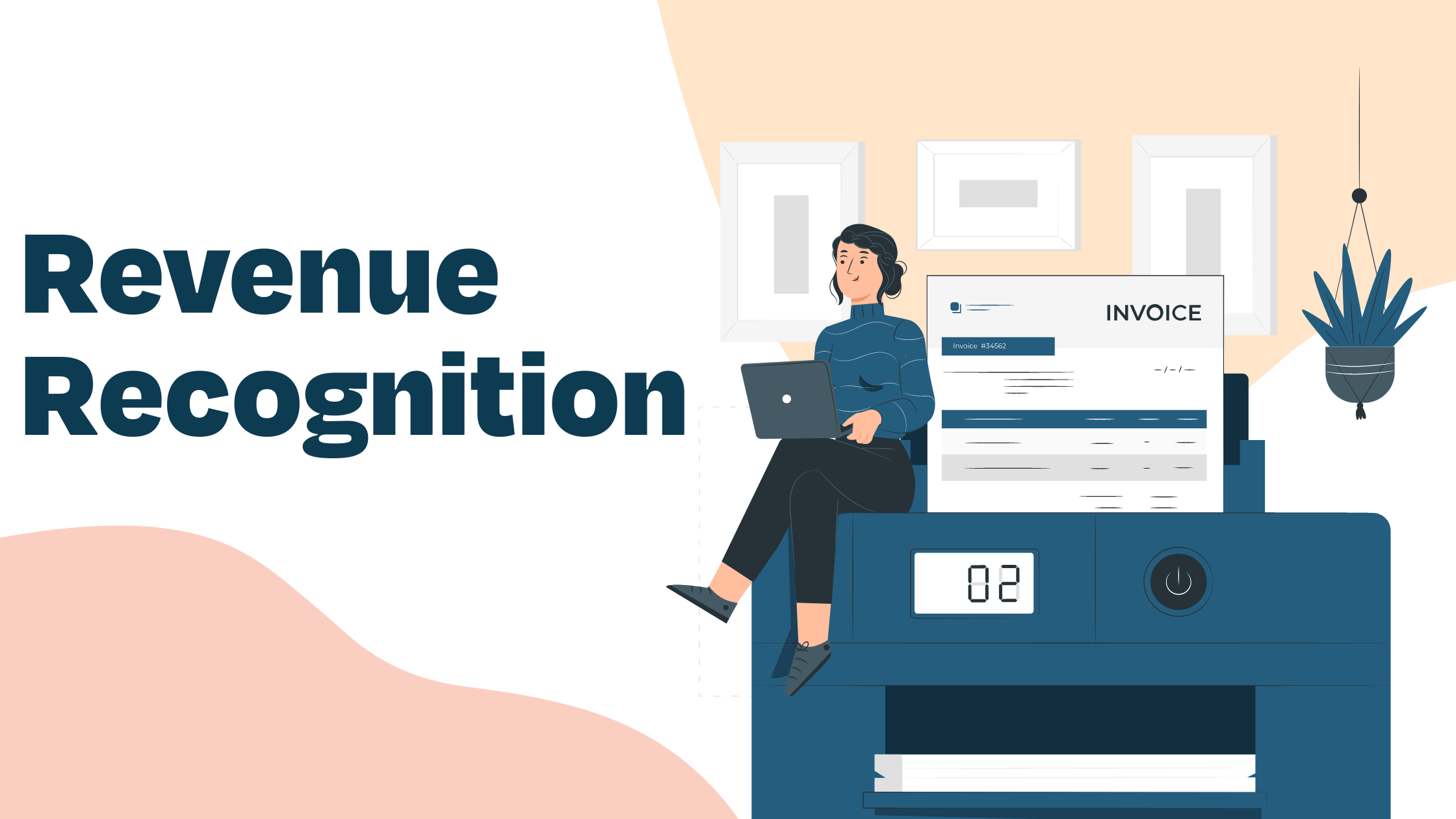1 min read
Understanding SaaS Revenue Recognition: Key Principles and Best Practices
Imagine this: You’re the founder of a thriving SaaS company. Your product is flying off the virtual shelves, customers are singing your praises, and...

As a business owner, tracking and recognizing your company's income accurately is essential for financial reporting, and understanding the process can help you achieve this goal.
Revenue recognition refers to the process of identifying and tracking revenue earned by a business. It involves several steps, and each stage plays an important role in ensuring accurate financial reporting. From identifying performance obligations to monitoring changes in transaction price and performance obligations, each step must be followed to track and recognize income in accordance with accounting standards.
In this blog post, we will discuss the five steps of revenue recognition, including identifying contracts with customers, determining performance obligations, allocating transaction prices, recognizing revenue, and accounting for contract modifications. By understanding the process, you will gain insight into how these stages work together and how to accurately track and recognize your company's income.
Accounting Standards Codification (ASC) 606 is a set of guidelines introduced in 2014 to standardize the way businesses recognize and report revenue. Before ASC 606, different industries followed different revenue recognition guidelines, leading to inconsistency in financial reporting. The new guidelines apply to all businesses and industries and outline a five-step process for recognizing revenue.
The first step in the process involves identifying the contract with the customer. This step requires businesses to define the terms of the contract, including the services or goods to be delivered, payment terms, and other relevant details. Once the contract is defined, the business can move on to the next step, which is identifying the performance obligations.
Performance obligations refer to the specific goods or services that must be completed before revenue can be recognized. For example, if a company sells a product that requires installation, the installation service would be considered a performance obligation. Once the performance obligations are identified, the business can determine the transaction price and allocate it among the obligations. This ensures that revenue is recognized accurately and in accordance with accounting standards. By following the guidelines set forth in ASC 606, businesses can ensure that their financial reporting is consistent, transparent, and in compliance with regulations.
Before any revenue recognition can take place, it is crucial to determine the contractual obligations between your business and your customers. This can take various forms such as written or verbal agreements, or even implied arrangements based on industry norms or established practices. It is essential to have a precise understanding of the terms and conditions, payment details, and any other rights and obligations of both parties.
To properly identify the contract, you need to review existing documents and look for any new agreements. You should also take note of any changes in the terms of the contract, particularly payment dates or additional items requested by either party. It is also important to identify each individual customer involved in the contract separately, so they can be accounted for accordingly during the revenue recognition process.
In addition to written contracts and verbal agreements, implied contracts may also need to be considered, depending on the industry or established practices between yourself and your customers. Once the contract is identified, you can move on to the next step of identifying performance obligations within the contract to ensure proper and timely revenue recognition.
The Collectability Threshold is an important concept in Accounting Standards Codification (ASC) 606 that refers to the amount of payment a company is expected to receive from its customers. The threshold is used to determine whether or not revenue from a particular contract should be recognized. The Financial Accounting Standards Board (FASB) has established guidelines for this threshold in ASC 606-10-25-1(e) and 606-10-55-3(a) through 55-3(c).
According to ASC 606-10-25-1(e), a company should not recognize revenue until it is probable that the payment for that revenue will be collected. This means that a company must consider the creditworthiness of its customers and any other factors that may affect their ability to pay before recognizing revenue from a particular contract. The collectability threshold is used to ensure that a company does not overstate its revenue by recognizing revenue from contracts that are unlikely to be paid.
ASC 606-10-55-3(a) through 55-3(c) further clarify the collectability threshold by providing examples of when revenue should and should not be recognized. For example, if a customer has a history of paying their bills on time and there are no other factors that may affect their ability to pay, then revenue from a particular contract should be recognized. However, if a customer has a history of late payments or there are other factors that may affect their ability to pay, then revenue from that contract should not be recognized until payment is received. Overall, the collectability threshold is an important aspect of revenue recognition that helps to ensure accurate financial reporting.
Under IFRS, the collectability threshold is more subjective than under GAAP. IFRS requires companies to assess the probability of collecting payments from the customer based on its creditworthiness and ability to pay, among other factors. If the company determines it is probable that it will receive the payment, then revenue can be recognized. This means that a higher degree of judgment is required, and there is more flexibility in determining collectability.
On the other hand, GAAP has a stricter approach to collectability. Under GAAP, revenue can only be recognized when it is considered "collectible." The collectability threshold is met only when the payment is probable and can be reliably estimated. In addition, GAAP has specific guidance on evaluating the collectability of contract assets, which are the right to receive payment for goods or services that have been transferred but not yet billed to the customer.
Overall, while both IFRS and GAAP have a collectability threshold, the approach and guidance provided for evaluating collectability differ. IFRS allows for more judgment and flexibility in determining collectability, while GAAP requires more objective criteria to be met before revenue can be recognized.
Once you’ve identified the contract with your customer, it's time to identify each promise you make to them. This is known as a performance obligation. A performance obligation is a distinct good or service, or a series of goods and services that are substantially the same and have the same pattern of transfer to the customer.
When determining what constitutes a performance obligation, consider how much control over each item you will retain during delivery and whether any items can be sold separately from other items in the contract. For example, if your company sells software subscriptions bundled with technical support services, then both would constitute separate performance obligations since they can be sold independently of one another.
In addition, think about how long it takes for each part of the transaction to be completed; if something takes longer than one year to complete then it likely qualifies as its own performance obligation too. When calculating revenue recognition, it is essential to bear in mind that varying types of products and services may necessitate distinctive approaches.
In Step 2, you must identify the performance obligations in the contract to ensure that your revenue recognition is accurate. Now it's time to move on and determine the transaction price for each of these identified performance obligations.
Determining the transaction price is an important step in recognizing revenue. Estimating the amount of consideration to be received for transferring goods or services is an integral part of determining the transaction price. The contract may include fixed consideration, variable consideration, or both types. If it includes variable consideration, you must estimate the amount of variable consideration you’re entitled to using either the expected value method or most likely amount method.
Pay close attention to the payment timing and the gap between transferring promised goods/services and when customers pay, in order to identify if a financing component is present. For instance, should your customer have requested an extension of credit terms beyond normal ones, this could signify a substantial financing element which needs to be accounted for separately from other components such as delivery fees per FASB's Accounting Standards Codification 606-10-25-18.
Under GAAP and IFRS, companies must only recognize satisfied revenue at each reporting period's end; any remaining revenue should be deferred until future periods when they become performance obligations that have been fulfilled according to the company's accounting method. Thus, cumulative revenues recognized over annual reporting periods beginning after December 15th 2017 cannot exceed the total transaction price minus amounts already acknowledged during prior intervals.
Step 3 of the revenue recognition process is an important step that requires careful consideration and analysis to ensure accuracy. With this in mind, Step 4 will focus on allocating the transaction price to each performance obligation within the contract.
Allocating the transaction price to each performance obligation in a contract is an important step of revenue recognition. This process requires assigning a value to each individual component or service provided within the agreement. To do this, you can use relative standalone selling prices, such as those from similar goods or services, a contractually stated price, or a list price.
If you cannot directly observe these prices, then other methods must be used for estimation. The adjusted market assessment method involves looking at comparable items and adjusting them based on factors like quality and quantity. Expected cost plus margin looks at expected costs associated with providing the good/service plus any desired profit margins added by the seller.
The last method is called residual analysis, which figures out how much money is left after assigning amounts to other obligations that can be more easily determined using the methods mentioned before.
It is essential to allocate the transaction price accurately and in accordance with the performance obligations outlined in a contract. This will ensure that revenue recognition can be properly tracked as per Step 5 of this process.
Step 5 of the revenue recognition process requires businesses to recognize revenue when, or as, they satisfy a performance obligation.
When recognizing revenue over time, businesses must apply a single method of measuring progress for each performance obligation. Progress can be assessed using a variety of approaches, e.g., units-of-delivery (quantity of goods provided) or cost-to-cost (cumulative costs compared to total estimated). It’s important to apply this same measurement consistently across similar performance obligations and remeasure it at the end of each reporting period.
Determining when a performance obligation has been fulfilled is paramount for recognizing revenue at the most appropriate point in time. If selling software licenses with immediate delivery, revenues can be recognized instantaneously upon purchase completion; conversely, if dealing with physical items which require shipment to customers, only then can related revenues be taken into account. To stay ahead of the curve and keep on top of your game, it's essential to apply consistent measurements across similar obligations while remeasuring progress at each reporting period.
Overall, accurately determining when to recognize revenue is essential for any business wanting to ensure proper financial reporting compliance while also avoiding costly penalties from potential audit findings down the line. By understanding these five steps of revenue recognition and implementing best practices accordingly within your organization’s internal processes you can rest assured knowing that your company’s financial statements are up to par with industry standards and regulations alike.
Recognizing revenue when or as the entity satisfies a performance obligation is an essential step in any business's financial process. Documenting these processes will help ensure that all transactions are properly accounted for and recorded accurately.
Several industries have faced significant challenges in implementing the ASC 606 standard, including telecommunications, software, and manufacturing. These industries often have complex and lengthy contracts with customers that may involve multiple performance obligations and variable consideration. For example, a software company may offer a suite of products that are sold together but have different standalone selling prices. Additionally, the company may offer customers discounts or other incentives that affect the transaction price, making it difficult to allocate revenue accurately.
The telecommunications industry also faces challenges with ASC 606, as many contracts involve long-term commitments and performance obligations that may change over time. For instance, a customer may sign a multi-year contract for internet services, but the company may need to upgrade the customer's equipment or provide additional services during that time. Determining how to allocate revenue for each performance obligation and how to account for changes in transaction prices can be complex and time-consuming.
In the manufacturing industry, companies may sell goods with warranties or provide ongoing maintenance and support for products. These obligations must be accounted for separately and may require estimates of future costs, making it challenging to determine the transaction price accurately. Additionally, the timing of revenue recognition may be impacted by factors such as when the customer takes ownership of the goods or when services are provided, leading to potential discrepancies in financial reporting
The documentation process should begin by identifying the relevant contracts and performance obligations. This may include analyzing the contract terms, such as pricing, delivery terms, and warranties, to determine the performance obligations and how revenue should be recognized. This process should also involve identifying any variable consideration, such as rebates or bonuses, and estimating their amounts as required by ASC 606.
Once the performance obligations have been identified, the next step is to document how the transaction price was determined. This may include determining the standalone selling prices of the individual components or services provided within the agreement or using other methods for estimation. It is important to document the assumptions and methods used to determine the transaction price in case they are challenged by auditors or regulators.
After determining the transaction price, the next step is to allocate it to each performance obligation. This involves assigning a value to each individual component or service provided within the agreement, using one of the methods outlined in ASC 606. This process should be documented thoroughly, including any assumptions or estimates used to allocate the transaction price.
It is also important to document any changes made to the revenue recognition process over time. This could include changes to accounting policies or methods, changes to contract terms, or changes to the estimate of variable consideration. Documentation of any changes will help to demonstrate that the company is in compliance with ASC 606 and has made appropriate adjustments as necessary.
Documentation should be maintained in a clear and organized manner, and should be easily accessible to auditors and other stakeholders. This may involve using a system such as a shared drive or document management software to ensure that all relevant documents are kept in a centralized location.
In addition to maintaining documentation, it is also important to have strong internal controls in place to ensure compliance with ASC 606. This may include implementing procedures for reviewing contracts and performance obligations, establishing controls over the estimation of variable consideration, and conducting regular audits to ensure that the revenue recognition process is being followed correctly.
The five steps of revenue recognition are a crucial part of the accounting process for any business. Realizing and recording revenue sources appropriately, in accordance with applicable laws and regulations, necessitates an understanding of these five steps. Accountingprose can help your small business stay on top of its financials by providing reliable services such as accrual-basis accounting, payroll, sales tax filing, and process optimization. Let us show you how we can help your business stay compliant with relevant laws and regulations while optimizing its financials.

1 min read
Imagine this: You’re the founder of a thriving SaaS company. Your product is flying off the virtual shelves, customers are singing your praises, and...
.png)
Bench is a popular online bookkeeping service that works with clients around the U.S., just like us. We often have potential clients call us and ask,...

If you’re running a SaaS company, you already know that managing finances isn’t as straightforward as it is for traditional businesses. The...